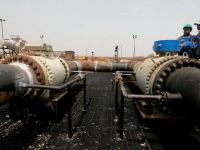Refining:PdVSA operates one of the Western Hemisphere’s largest refining systems and is one of the world's largest oil refiners. Domestic refinery capacity stands at about 1.3 million bbl/d, with significant additional holdings in Curaçao, the United States (in Lake Charles, Lemont, Corpus Christi, Paulsboro, Savannah, and Lyondell), and Europe (with Nynas and Ruhr Oel).
Venezuela plans to invest $2.6 billion in refinery upgrades over the next five years, mostly for improving product quality rather than expanding capacity.
Upgrading the Isla Refinery and the Paraguaná complex (home to about 70 percent of Venezuela's refinery capacity) will be top priorities, as well as construction and expansion at the Puerto La Cruz, Amuay, and Cardon refineries.
PdVSA now has a reformulated gasoline production capacity of about 200,000 bbl/d. About one-third of Venezuela's refined product exports are exported to the United States, where they are distributed mainly by Tulsa-based Citgo, PdVSA's U.S. refining and marketing subsidiary, and one of the largest U.S. gasoline retailers.
Orimulsion: Orimulsion is a branded product that is used as a boiler fuel, similar to #6 fuel oil. It is an emulsion of approximately 70 percent natural bitumen, 30 percent water, and less than 1 percent surfactants (emulsifiers).
Bitumen is considered a non-oil hydrocarbon and is not counted towards Venezuela's OPEC crude oil production quota.
Burning Orimulsion in conventional power plants produces emissions of carbon dioxide, sulfur dioxide, and nitrogen oxide roughly similar to emissions from fuel oil.
Bitor, a PdVSA subsidiary, manages the processing, shipping and marketing of Orimulsion. Bitor now operates one Orimulsion plant in Cerro Negro, with a capacity of 5.2 million metric tons per year, and hopes to produce 20 million metric tons per year by 2006.
According to Bitor, more than 1.2 trillion barrels of bitumen exist in the Orinoco Belt. Economically recoverable reserves are now estimated at about 267 billion barrels. Canada, China, Denmark, Guatemala, Italy, Japan, and Lithuania either consume or are considering consuming Orimulsion.
Natural Gas: Venezuela has proven natural gas reserves of about 146.8 trillion cubic feet (Tcf), the most in Latin America and among the largest in the world.
Current plans call for exploration to increase Venezuela's proven reserves. The country produced only about 1 Tcf in 1999. Domestic demand is relatively low (about 1 Tcf was consumed in 1999), largely because Venezuela's highly developed hydropower industry thus far has precluded the use of gas for power generation.
About 60 percent of the country's gas production is consumed by the oil industry, which either re-injects the gas into oil fields or flares it; about 10 percent is consumed for power generation; 6 percent is used in petrochemical production; and the rest is used mainly by industrial or commercial customers in large cities.
The Chávez administration plans to increase gas production and consumption.PdVSA traditionally has had a monopoly on Venezuelan natural gas production.
Foreign companies, such as Shell, have operated in joint ventures with PdVSA. However, August 1999 legislation opened up the sector to foreign investment in exploration and production, distribution, transmission, and gasification (although no company would be allowed to explore, produce, and transport in the same region).
The law allows for up to 20 percent to be charged in royalties. To date, there has been one licensing round for natural gas exploration and production, in 1996. Three consortia, led by Burlington, TotalFinaElf, and BP, want to return oil exploration blocks that they won in that round because of disappointing exploration results.
Of the five blocks still under contract, only the Gulf of Paria West, operated by Conoco, yielded a big find.
A second licensing round for 11 exploration and production areas, scheduled for December 2000, has been pushed back until at least spring 2001. PdVSA attributed the delay to unresolved tariff issues.
Twenty-eight foreign and domestic companies have been qualified to bid, including ExxonMobil, BP, ENI, Chevron, Texaco, and Repsol YPF.
Two of the new areas offered have proven gas reserves of 2 Tcf and further exploration potential. The remaining areas are considered to be more risky.
Existing natural gas infrastructure consists of 3,000 miles of pipeline, and Venezuela is seeking foreign investors to help expand this network.
At least seven new privately-built pipelines are planned as part of a ten-year, $8-10 billion natural gas project to decrease the country's reliance on oil. The first pipeline, to be built by U.S.-based CMS, currently is facing delays.
Venezuela is interested in connecting its gas distribution network to that of neighboring Colombia. Through Colombia, Venezuela could connect to much of the South American continent. It also is interested in connecting with northern Brazil.
Coal: Venezuela has recoverable coal reserves of approximately 528 million short tons (Mmst), most of which is bituminous. Venezuela is the third largest producer of coal in Latin America, after Colombia and Brazil.
Production in 1999 amounted to over 8 Mmst, almost all of which was exported to other countries in the region, the eastern United States, and Europe. Domestic consumption in 1999 was only about 13 thousand short tons.
The Guasaré Basin, near the Colombian border, is the major coal producing region in Venezuela. Coal production has been limited during the last several years by infrastructure and transportation constraints.
The government announced in April 1999 intentions to increase production of high-quality coal to 21 million tons per year by 2008. Venezuela's coal sector is dominated by Carbozulia, which is owned by PdVSA.
Energy Overview:
Minister of Energy and Mines: Alvaro Silva Calderon
Head of PdVSA: General Guaicaipuro Lameda Montero
Proven Oil Reserves (1/1/01): 76.8 billion barrels
Oil Production (2000E): 3.1 million barrels per day (bbl/d), of which 2.9 million bbl/d was crude
OPEC Crude Oil Production Quota (2/1/01): 2.9 million bbl/d
Oil Consumption (2000E): 476,000 bbl/d
Net Oil Exports (2000E): 2.6 million bbl/d
Crude Oil Refining Capacity (1/1/01): 1.3 million bbl/d in Venezuela, with almost 2 million bbl/d of capacity in the Caribbean, the United States and Europe
Major Crude Oil Customers: United States, Canada, Germany, Spain
Oil Exports to the United States (first 10 months of 2000): 1.5 million bbl/d, of which 1.2 million bbl/d was crude
Natural Gas Reserves (1/1/01): 146.8 trillion cubic feet (Tcf)
Natural Gas Production/Consumption (2000E): 1.0 Tcf
Coal Reserves (12/31/96): 528 million short tons (Mmst)
Coal Production (1999E): 8.32 Mmst
Coal Consumption (1999E): .01 Mmst
Electric Generation Capacity (1/1/99E): 21.5 gigawatts
Electricity Production (1999E): 81.2 billion kilowatthours (68 percent hydroelectric)
Oil & Gas industries:
Organization, Oil and Natural Gas: Petroleos de Venezuela, S.A. (PdVSA, state-held), with some foreign companies involved in joint ventures; Coal: Carbozulia, owned by PdVSA, with some foreign companies involved in joint ventures; Electricity: Several state-held and private utilities, with Edelca as the largest public utility and Elecar as the largest private utility
Major Foreign Oil Company Involvement: Arco, BP Amoco, Chevron, CNPC (China), Conoco, ExxonMobil, Occidental, Pennzoil, Phillips, Repsol-YPF, Shell, Statoil, Texaco, TotalFina, Union Texas, and Veba Oel
Major Domestic Refineries (crude capacity-bbl/d) (1/1/00), PdVSA: El Palito, Puerto Cabello (126,900), Puerto de la Cruz (195,000), San Roque, Anzoategui (5,200); Paraguana Refining Center: Cardon, Falcon (288,230), Judibana, Falcon (612,750), Maracaíbo, Zulia (10,800)
Major Oil Fields: Lagunillas, Bachaquero, El Furrial, Centro, Mulata, Lama
Oil Terminals: El Palito, Judibana (Amuay), La Salina, Maracaíbo, Puerto La Cruz, Puerto Miranda, Punta Cardon
Source:United States Energy Information Administration.
© 2001 Mena Report (www.menareport.com)







